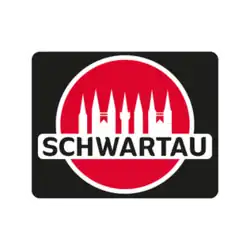Schwartauer Werke
 | |
| Company type | Private |
|---|---|
| Industry | Food |
| Founded | 1899 in Bad Schwartau, Germany |
Number of employees | 950 (2024) |
| Parent | Hero Group |
| Website | www |
Schwartauer Werke (colloquially Schwartauer) is a German food manufacturing company based in Schleswig-Holstein. Over 950 employees work at its headquarteres in Bad Schwartau, Germany.[1] Founded in 1899 it manufactures jams, spreads, dessert products, sirups and muesli and protein bars. In the 1960's, Ursula Oetker inherited the company and it was later, under the management of her son Arend Oetker, turned into a market leader[2] Since 2002, Schwartauer was integrated into Hero Group (which is owned by Dr. Arend Oetker Holding GmbH & Co KG).[3]
History
Company Founding
The company was founded in 1899 by the brothers Paul (* February 27, 1871 in Rostock[4]) and Otto Fromm (* August 8, 1872 in Rostock; † August 15, 1915 in Berlin) as a general partnership under the name "Chemische Fabrik Schwartau". In the early years, artificial honey, cranberry compote, and plum jam were produced, as well as floor wax and floor oil. In 1904, a jam production department was established.[5] In 1907, a sugar refinery was founded and from then on, the company focused on the production of fruit-based products.[6]
With the change in the product range, the company name was changed from the Chemical Factory to the "Schwartauer Honigwerke & Zuckerraffinerie Aktiengesellschaft" in 1912. In order to transport the raw food products as quickly as possible to the factory for further processing and sale, a railway connection was created.[7] Also in 1912, Schwartau released its first jam on the market, the Schwartau Five-Fruit Jams.[8] During the First World War, Schwartau benefited from the wartime economic boom and was able to distribute dividends in the double-digit percentage range. At the same time, however, the Schwartau factories also had to cope with a shortage of labor and the raw material sugar.[9] After Otto Fromm died in 1915 and his brother Paul had left the company, board members Gerhard Blümer and Franz Schrader took over the management.[9]
Weimar Republic and National Socialism
In 1922, the subsidiaries "Lübecker Pralinen- und Konfitürenfabrik GmbH" (Lübecker Pralinen- und Konfitürenfabrik GmbH) for jams and pralines and "Lübecker Marzipan- und Backmassenfabrik GmbH" (Lumaba) for marzipan and baking mixtures were founded.[10] In 1924, another subsidiary, "Mablo-Werke GmbH," was founded, which was intended to both promote its own raw paste and specifically attract customers from the processing industry.[11] Also in 1924, Fritz Sierig became a member of the board of directors, and until his death in 1953, was the company's long-term managing director.[12]
In 1924, the artist Alfred Mahlau designed the trademark of Schwartauer Werke, the towers of the five churches ("Seven Towers") of Bad Schwartau's neighbouring town of Lübeck, seen from north to south: St. James' Church, St. Mary's Church, St. Peter's Church, St. Aegidien Church, and Lübeck Cathedral.[13]
In 1927, Schwartauer Werke, the Lübeck Marzipan and Baking Mass Factory, and the Lübeck Praline and Jam Factory were merged to create Schwartauer Werke AG.[6] The company survived the Great Depression by reducing jam prices, financed by reduced wages for employees and the board of directors, and other savings.[14]
During the Nazi era, Schwartauer Werke AG also employed forced laborers. They had their own civilian labour camp with around 110 inmates.[15][16] Jam was promoted by the Nazis as a "people's spread," and in the 1930s, Schwartauer Werke was steered toward self-sufficiency for the impending Second World War.[17]
Towards the end of the Second World War, production declined sharply due to raw material shortages, but the Schwartauer Werke buildings remained undamaged by bombing raids.[18]
Postwar period
In the postwar period, the company increased its workforce from around 500 people in 1950 to up to 1,000 people during the harvest season at the end of the 1950s. Among its products, the jam business was more successful than other branches of the company and ultimately became its core business.[19] Between 1950 and 1961, the company's sales doubled to approximately 58.5 million German marks.[20]
In 1959, the company was converted into a GmbH (limited liability company), whereby the Oetker family, which had already held shares in Schwartauer AG since the 1930s, acquired a majority stake in the company.[21] In 1962, Schwartauer Werke introduced Schwartau Extra jam, which is still sold today.[6] However, in the first half of the 1960s, the company's growth faltered.[20]
Through inheritance, Ursula Oetker became the sole shareholder of Schwartauer Werke in the mid-1960s. At that time, however, the company was largely unprofitable and considered a restructuring case.[22]
Modernization and Internationalization under Arend Oetker


In 1968, Ursula Oetker's son, Arend Oetker, took over the company and the chairmanship of the management of Schwartauer Werke. Under his leadership, Schwartauer Werke was restructured and became more internationally oriented.[23] He also improved Schwartauer Werke's positioning as a manufacturer of branded goods.[24] Within the next twenty years, the company increased its sales tenfold.[25] From the 1970s onward, the company's management consisted of Arend Oetker, Werner Holm, and Lutz Peters for almost 30 years, until the latter two left the operational business in 2002.[26]
In 1981, production of a muesli bar began, which has been sold under the Corny brand since 1984. Schwartauer Werke was one of the first European companies to introduce muesli bars from the United States.[6] The muesli bars are produced in the so-called Corny factory in Bad Schwartau.
In 1986, Schwartauer Werke acquired a license to use the Mövenpick name for fruit spreads[27] and established it as a premium brand in the German market. In August 2004, the contract between Schwartauer Werke and Mövenpick was extended long term.[28][29] In 1986, construction began on the Schwartau advertising tower, which was completed in May 1987. To this day, the tower remains the landmark of Schwartauer Werke.[30]
In 1995, Schwartauer Werke acquired a majority stake in the Swiss food manufacturer Hero AG, which already had several subsidiaries at the time. Both companies served different markets in Europe and the merger of the two was seen as economically beneficial.[31]
At the company's 100th anniversary in 1999, Schwartauer Werke covered around 40 percent of the jam market in Germany. At that time, around 700,000 jars of jam were produced daily, which were exported to 35 countries. Sales revenues amounted to 2.7 billion German marks.[32]



References
- ^ "Schwartauer Werke GmbH & Co KGaA - Company Profile and News". Bloomberg.com. Retrieved 2024-07-23.
- ^ manager, Christoph Neßhöver (2021-11-03). "Arend Oetker und Bad Schwartau: Was der Marmeladenkönig heute macht". www.manager-magazin.de (in German). Retrieved 2024-07-23.
- ^ NDR. "Schwartauer Werke: Nach Bohnerwachs auf Konfitüre und Müsli-Riegel spezialisiert". www.ndr.de (in German). Retrieved 2024-07-23.
- ^ "Paul Fromm (1892 SS (Kl. Matr.)) @ Rostocker Matrikelportal". matrikel.uni-rostock.de. Retrieved 2025-07-15.
- ^ Prey, Sebastian (2025-07-09). "Bad Schwartauer Werke: Ehrung zum 150. Geburtstag von Gründer Otto Fromm". www.ln-online.de (in German). Retrieved 2025-07-15.
- ^ a b c d "Unsere Geschichte - Zeitreise gefällig?". Schwartauer Werke (in German). Retrieved 2025-07-15.
- ^ Prey, Sebastian (2025-07-09). "Bad Schwartauer Werke: Ehrung zum 150. Geburtstag von Gründer Otto Fromm". www.ln-online.de (in German). Retrieved 2025-07-16.
- ^ "Unsere Geschichte - Zeitreise gefällig?". Schwartauer Werke (in German). Retrieved 2025-07-16.
- ^ a b Vogt, Christian (2019). Süßes von Wert – 120 Jahre Schwartauer Werke. Teil Eins (in German). Hamburg: Firmengeschichten Hamburg. pp. 21, 23.
- ^ Vogt, Christian (2019). Süßes von Wert – 120 Jahre Schwartauer Werke (in German). Hamburg: Firmengeschichten Hamburg. p. 27.
- ^ Vogt, Christian (2019). Süßes von Wert – 120 Jahre Schwartauer Werke (in German). Firmengeschichte Hamburg. p. 27.
- ^ Vogt, Christian (2019). Süßes von Wer t– 120 Jahre Schwartauer Werke (in German). Firmengeschichte Hamburg. p. 33.
- ^ "Nichts als die nackte Wahrheit in Bad Schwartau". FAZ.NET (in German). 2020-06-18. Retrieved 2025-07-16.
- ^ Vogt, Christian (2019). Süßes von Wert – 120 Jahre Schwartauer Werke (in German). Firmengeschichte Hamburg. p. 44.
- ^ Weinmann, Martin; Kaiser, Anne, eds. (2001). Das nationalsozialistische Lagersystem: CCP (4. Aufl ed.). Frankfurt am Main: Zweitausendeins. ISBN 978-3-86150-261-6.
- ^ Schwarz, Rolf (1985). Verschleppt zur Sklavenarbeit. Kriegsgefangene und Zwangsarbeiter in Schleswig-Holstein. Bremen.
{{cite book}}: CS1 maint: location missing publisher (link) - ^ Vogt, Christian (2019). Süßes von Wert – 120 Jahre Schwartauer Werke. Teil Eins (in German). Firmengeschichten Hamburg. pp. 47–53.
- ^ Vogt , S. 57–58., Christian (2019). Süßes von Wert – 120 Jahre Schwartauer Werke. Teil Eins. Firmengeschichten Hamburg. pp. 57–58.
{{cite book}}: CS1 maint: location missing publisher (link) CS1 maint: numeric names: authors list (link) - ^ Vogt, Christian (2019). Süßes von Wert – 120 Jahre Schwartauer Werke (in German). Firmengeschichten Hamburg. p. 76.
- ^ a b Vogt, Christian (2019). Süßes von Wert – 120 Jahre Schwartauer Werke. Teil Zwei. Firmengeschichten Hamburg. p. 5.
- ^ Vogt, Christian (2019). Süßes von Wert – 120 Jahre Schwartauer Werke. Teil Eins. Firmengeschichten Hamburg. pp. 60, 76–77.
- ^ "Ursula Oetker: Konfitüren-Königin ist tot". www.manager-magazin.de (in German). 2005-12-28. Retrieved 2025-07-23.
- ^ "Junge DGAP: Privatissimum mit Dr. Arend Oetker | DGAP". dgap.org. Retrieved 2025-08-05.
- ^ Vogt, Christian (2019). Süßes von Wert – 120 Jahre Schwartauer Werke. Teil Zwei. Firmengeschichten Hamburg. p. 8.
- ^ "Im Reich des anderen Oetker". stern.de (in German). 2004-09-09. Retrieved 2025-08-05.
- ^ Vogt, Christian (2019). Süßes von Wert – 120 Jahre Schwartauer Werke. Teil Zwei. Firmengeschichten Hamburg. p. 74.
- ^ Graf, Alexander (2021-10-22). "Wie funktioniert eigentlich Mövenpick? Mit Steffen Rutter | Kassenzone". www.kassenzone.de (in German). Retrieved 2025-08-08.
- ^ "Mövenpick und Schwartau verlängern Lizenzpartnerschaft | Mövenpick". group.movenpick.com (in German). Archived from the original on 2016-01-04. Retrieved 2025-08-08.
- ^ "Wirtschaft: Mövenpick mit Schwartau" (in German). Retrieved 2025-08-08.
- ^ "Farbe für den Schwartau-Turm". www.ln-online.de (in German). 2015-10-20. Retrieved 2025-08-08.
- ^ Vogt, Christian (2019). Süßes von Wert – 120 Jahre Schwartauer Werke. Teil Zwei. Hamburg: Firmengeschichten Hamburg. pp. 56, 58.
- ^ "Die Schwartauer Werke werden 100 Jahre alt - WELT". DIE WELT (in German). Retrieved 2025-08-11.